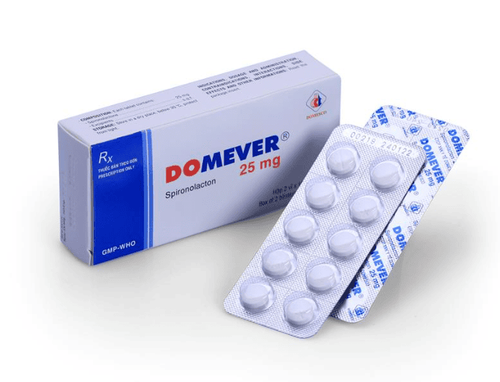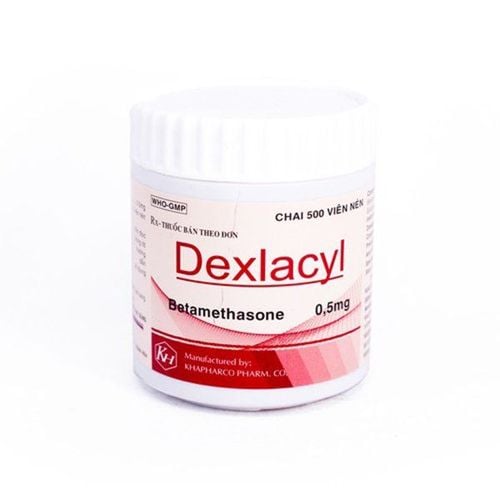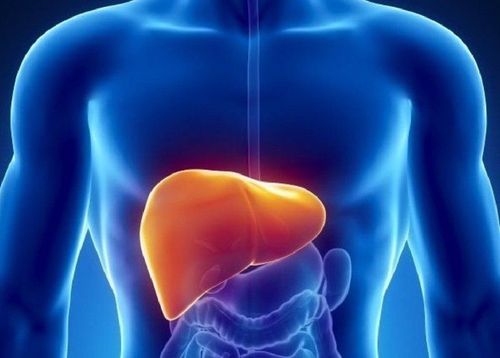This is an automatically translated article.
Spinolac medicine 25mg belongs to the group of diuretics, the main ingredient is spironolactone. The drug is used in the treatment of hypertension, edema caused by congestive heart failure, cirrhosis of the liver ascites, nephrotic syndrome, primary hyperaldosteronism.
1. Uses of the drug Spinolac
The active ingredient Spironolactone belongs to the group of potassium-sparing diuretics. In the distal tubule, Spironolactone is responsible for inhibiting the ability of the kidneys to retain water and Na + ions, and at the same time inhibiting the ability to eliminate K + ions caused by aldosterol.Therefore, Spironolactone increases the excretion of Na + and Cl- ions, retains K + ions, and at the same time reduces the excretion of H + ions into the urine, leading to a decrease in blood pressure of the user.
Spinolac drug 25mg is used in the following specific cases:
Congestive heart failure Severe heart failure Cirrhosis ascites Edema Nephrotic syndrome Support and treatment of primary hyperaldosteronism Patients with high blood pressure Prophylactic treatment Preventing a decrease in blood potassium levels when taking digitalis drugs.
2. How to use Spinolac 25mg
2.1. How to take Spinolac 25mg is used orally. Patients should combine the drug with food with a dose greater than 100 mg should be divided into several small doses. However, avoid taking the drug with alcohol, beer, coffee or some other stimulants.
2.2. Dosage The dose of the drug will depend on the patient's medical condition and age, specifically:
Edema due to congestive heart failure: The first dose is 100mg/day, taking a single dose or dividing the dose. Alternatively, a dose of 25-200 mg/day can be used. Severe heart failure: Initial dose 25 mg/time/day (provided plasma potassium concentration ≤ 5 mEq/L, creatinine concentration ≤ 2.5 mg/dL). Patients who tolerate a dose of 25 mg once daily can be increased to 50 mg once daily. Patients who are intolerant to 25 mg once daily can be reduced to 25 mg every other day. Cirrhosis, ascites and edema: The dose is 100 mg/day if the Na+/K+ ratio < 1 and from 200-400 mg/day if the Na+/K+ ratio <1. Nephrotic syndrome: The usual dose is 100-200 mg/day. Resistant hypertension: The first dose is 25mg/time/day. The dose may be gradually increased to 100 mg/day or more. Long-term test: Dosage is 400 mg/day and lasts for 3-4 weeks. Short-term test: The dose is 400mg/day, twice a day for 4 days. If serum potassium increases during spironolactone administration, but decreases when spironolactone is discontinued, primary hyperaldosteronism may be considered. Dose 300-400mg/day in case of surgery. For patients not suitable for surgery, spironolactone should be used as long-term maintenance therapy at the lowest dose. In the case of using spironolactone for the elderly, treatment should be started from the lowest dose and then gradually increased if maximum effectiveness is achieved. Spionolactone should be used with caution in patients with severe renal and hepatic impairment. Children: Initial dose 1-3 mg/kg/day, divided into 2-3 oral doses. Note that at this age, the dose should be adjusted based on the response and tolerability of the body. 2.3. What to do in case of overdose? Currently, there is no specific antidote for Spironolactone overdose. The patient may experience some symptoms of overdose such as:
Drowsiness Restlessness Nausea/vomiting Dizziness Dizziness Diarrhea Low blood pressure However, these symptoms will improve with the drug is removed from the body body. If the patient is dehydrated and the electrolyte balance is disturbed, symptomatic treatment is needed. Patients can take diuretics, intravenous glucose with insulin or take ion exchange resins when hyperkalemia.
2.4. What to do if you miss a dose? If you miss a dose, take it as soon as you remember. If it is almost time for the next dose, skip the make up dose and take the medicine in the planned sequence. Never double the dose to make up for it.
3. What are the side effects of Spinolac?
During the use of Spinolac 25mg, patients may experience undesirable effects such as:
Hyperkalemia, reproductive system disorders (big breasts in men) Increased platelets Eosinophilia Decreased white blood cell count Agranulocytosis Eczema Hypersensitivity Breast cancer Mild virilization (hirsutism) Hyperkalemia (in case of severe renal failure) Hyponatremia Acidosis Dehydration Porphyria disorders Hyperuremia Restlessness Headache Asthenia Coma in patients with liver failure Lower extremity paralysis Vasculitis Mild hypotension Indigestion Diarrhea Nausea/vomiting Stomach ulcer Gastrointestinal bleeding Hepatitis Skin rash, urticaria, tinea pedis, exanthema Stevens syndrome - Johnson Toxic skin necrosis Muscle contractions and cramps Systemic lupus erythematosus Osteomalacia. Increase in plasma creatinine, acute renal failure, erectile dysfunction, mammary gland disorder, menstrual disorder, when experiencing any side effects of Spinolac 25mg, the patient should stop using the drug and immediately go to the nearest medical facility for information. Notify your doctor or pharmacist for the most prompt treatment.
4. Notes when using Spinolac 25mg
Before using the drug, the patient should carefully read the instructions for use and refer to the information below.
4.1. Contraindications Spinolac drug 25mg is not used in the following cases:
Hypersensitivity, allergy to spironolactone or to any ingredient in the drug. Severe renal failure, acute renal failure or advanced kidney disease, kidney damage, dysuria. Addison's disease. Hyperkalemia. Reduced blood sodium. Concomitant use with eplerenone or potassium-sparing diuretics, potassium supplements. Children with moderate to severe renal failure. 4.2. Precautions for use In the process of taking spironolactone for treatment, it is necessary to monitor and control the status of fluids and electrolytes regularly, especially in the elderly, people with liver and kidney failure. Hyperkalemia can be fatal in patients with renal failure, abnormal heart rhythms, or excessive potassium tolerance. Stop using the drug if absolutely necessary. There have been reports of patients with decompensated cirrhosis or normal renal function recovering from metabolic acidosis with elevated blood chloride often associated with hyperkalemia. Using Spinolac 25mg in combination with potassium-sparing diuretics, non-steroidal anti-inflammatory drugs, ACE inhibitors, angiotensin II drugs, aldosterone, heparin, heparin, potassium supplements, a diet rich in potassium, potassium salts, ... may pose a risk of severe hyperkalemia. When using spironolactone can reverse hyperuremia, especially in patients with renal failure. There have been reports of fatal hyperkalemia. In patients with severe heart failure who are taking spironolactone, serum potassium should be checked and closely monitored. Potassium-sparing diuretics should not be used in this case. Patients with serum potassium levels > 3.5 mEq/L should avoid taking potassium supplements. Regularly check serum potassium and creatinine after 1 week for the first 3 months of dosing or increasing the dose. After that, every 4 times/year and 6 months/year check. Discontinue when serum potassium > 5 mEq/mL or serum creatinine > 4 mg/dL. A slight increase in blood pressure and renal impairment is possible with the use of potassium-sparing diuretics in children, because of the risk of hyperkalemia. Side effects of somnolence and dizziness have been reported with spironolactone. Therefore, care should be taken when driving and operating machinery. Spironolactone can cross the placenta. Therefore, if using Spinolac 25mg for pregnant women, it should be carefully considered when the benefits outweigh the possible risks to the mother and fetus. Since spironolactone can be metabolized in breast milk, it should not be used during breast-feeding. If Spinolac 25mg is required, discontinue nursing.
5. Spinolac drug interactions
Here are some drugs when combined with Spinolac 25mg that can cause interactions:
The drugs trimethoprim, sulfamethoxazole combined with spironolactone cause severe hyperkalemia. Spironolactone in combination with digoxin will increase plasma digoxin concentrations and may interfere with the quantification of digoxin plasma concentrations. Antihypertensive drugs need to be reduced in dose when co-administered with spironolactone. Because enzyme inhibitors specifically reduce aldosterone production, do not use spironolactone regularly, especially in patients with renal failure. Carbenoxolone should not be combined with spironolactone because it can cause sodium retention and reduce the effectiveness of spironolactone Anti-inflammatory drugs such as aspirin, indomethacin, mefenamic acid will reduce the sodium excretion effect of diuretics by inhibiting prostaglandin synthesis. on the kidneys and reduce the diuretic effect of spironolactone. The active ingredient Spironolactone may decrease vascular responsiveness when used with noradrenalin. In case the patient is anesthetized while being treated with spironolactone, caution should be exercised. Concomitant use of Spironolactone with Antipyrin will increase the metabolism of antipyrin. Spironolactone in combination with anticoagulants reduces the anticoagulant effect Increases the risk of lithium toxicity, as diuretics reduce the renal clearance of lithium. When using together Spironolactone with alcohol, beer, anesthetics, sedatives can cause orthostatic hypotension. Cholestyramine and ammonium chloride can cause metabolic acidosis with elevated blood chloride. Corticosteroids and ACTH will increase electrolyte loss, especially hypokalemia. Please consult with your doctor, pharmacist, or medical professional before using Spinolac 25mg to minimize possible side effects and drug interactions. Note that the information on the article is for reference only, cannot replace the instructions for use and instructions from doctors and pharmacists.
Follow Vinmec International General Hospital website to get more health, nutrition and beauty information to protect the health of yourself and your loved ones in your family.
Please dial HOTLINE for more information or register for an appointment HERE. Download MyVinmec app to make appointments faster and to manage your bookings easily.













